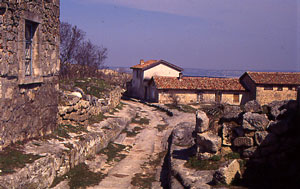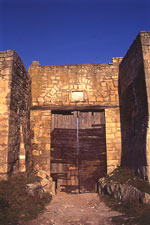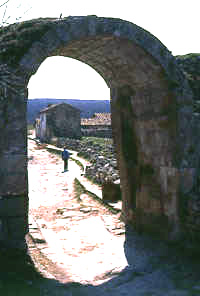
In Antiquity
In the Middle Ages
Near Outlying Areas
Far Outlying Areas
Mangup-Kale cave town
Eski-kermen
Chufut-Kale fortress
Tepe-Kermen site
Bakla cave town
Kyz-Kermen fortress
Kachi-Kal'on cave monastery
Chelter-Marmara monastery
Shuldan monastery
Kyz-Kule site
(Jews' fortress)
Late 6th to late 19th century

Chufut-Kale (Tatar for "Jew's fortress") is located not far from Bakhchisaray, on the plateau that towers 200 m above neighboring valleys and is limited with precipices up to 50 m high from three sides. This fortress was established in the late 6th or 7th century as a Byzantine stronghold and populated with local tribes of the Alans, who were the allies of the Empire.
 |
This town territory is traditionally divided into three well-visible parts: Burunchak, that is western section of the plateau where was no buildings, covering the area about 36 hectares; the Old town, covering the area of about 7 hectares, which was separated from the wasteland by a low wall; and the New town, covering more than 3 hectares and located between the Middle and the Eastern defensive walls. |
The name of Kyrk-Or, or "forty forts" in Turkish, appeared in the 13th century. In 1340s, under Djanibek khan, the fortress fell into the hands of the Tartars. In the 15th century, Chufut-Kale became the first capital of the Crimean Khanate and the residence of the first Crimean khans Haji-Girey and Mengli-Girey. In the 16th century, the capital was moved to Bakhchesaray, and the population of Kyrk-Or restricted to a small Armenian community and, mainly, the Karaites, who adhered to a non-Talmud Judaism. From the 17th century onwards, the town was known as Chufut-Kale or "Jewish fortress."
| The 17th century Ottoman traveler Evliya Celebi informed of another, little known name of this city: Gevherkermen, literally "Fortress of Treasures". In 1778, the Russian government organized the emigration of the Christians from the Crimea, after which only the Karaites continued to live in Chufut-Kale. The last inhabitant, the Karaite scholar and well-known collector of ancient manuscripts Avraam Firkovich, left Chufut-Kale in the late 19th century. |  |
Today, the site of Chufut-Kale presents the fortification system with defensive walls, southern and eastern gates, and towers; streets with narrow sidewalks, dwelling houses, praying houses of the Karaites, or "kenassas"; the mausoleum of Djanike-Khanym who were the daughter of the khan Tokhtamysh; and cave constructions, which were carved for various purposes.
